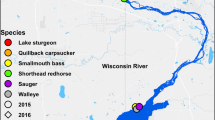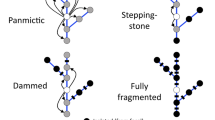Abstract
Most of the world's large rivers are fragmented by dams. Fragmentation of the river ecosystem alters migration patterns among fish populations and converts free-flowing river to reservoir habitat. In this study, we used an individual-based genetic metapopulation model to study the effects of fragmentation on the population viability and genetic diversity of a large-river fish, the white sturgeon, Acipenser transmontanus. In the first of two simulation experiments, we fragmented a 200 km river reach by building 1 to 20 virtual dams. Increased fragmentation produced an exponential decline in the likelihood of persistence, but no extinction threshold to suggest a minimum viable length of river. Compounding isolation with the loss of free-flowing habitat did not further reduce viability until free-flowing habitat was nearly eliminated, at which point extinction was certain. Genetic diversity within (among) populations decreased (increased) as we ‘built’ the first several dams. Adding more dams caused the number of persisting populations to decline and eroded genetic diversity within and among populations. Our second simulation experiment evaluated the effects of different levels of upstream and downstream migration between river segments. The results of these migration experiments highlighted the importance of balanced migration rates. We found that extinction risk was high for populations linked by high downstream, and low upstream, migration rates, as is often the case in impounded rivers. Our results support the view that migration patterns will play a significant role in determining the viability of riverine fishes, such as the white sturgeon, in river ecosystems fragmented by dams.
Similar content being viewed by others
References
Auer, N.A. 1996a. Importance of habitat and migration to sturgeons with emphasis on lake sturgeon. Can. J. Fish. Aquat. Sci. 53(Suppl. 1): 152–160.
Auer, N.A. 1996b. Response of spawning lake sturgeons to change in hydroelectric facility operation. Trans. Amer. Fish. Soc. 125: 66–77.
Bartley, D.M., G.A.E. Gall & B. Bentley. 1985. Preliminary description of the genetic structure of white sturgeon, Acipenser transmontanus, in the Pacific Northwest. pp. 105–109. In: F.P. Binkowski & S.I. Doroshov (ed.) North American Sturgeons: Biology and Aquaculture Potential, Developments in Env. Biol. Fish. 6, Dr W. Junk Publishers, Dordrecht.
Bascompte, J. & R.V. Sole. 1996. Habitat fragmentation and extinction thresholds in spatially explicit models. J. Anim. Ecol. 65: 465–473.
Beamesderfer, R.C.P., T.A. Rien & A.A. Nigro. 1995. Differences in the dynamics and potential production of impounded and unimpounded white sturgeon populations in the lower Columbia River. Trans. Amer. Fish. Soc. 124: 857–872.
Beamesderfer, R.C.P. & R.A. Farr. 1997. Alternatives for the protection and restoration of sturgeons and their habitat. Env. Biol. Fish. 48: 407–417.
Birstein, V.J., W.E. Bemis & J.R Waldman. 1997. The threatened status of Acipenseriform species: a summary. Env. Biol. Fish. 48: 427–435.
Brown, J.H. & A. Kodric-Brown. 1977. Turnover rates in insular biogeography: effect of immigration on extinction. Ecology 58: 445–449.
Brown, J.R., A.T. Beckenbach & M.J. Smith. 1992a. Mitochondrial DNA length variation and heteroplasmy in populations of white sturgeon (Acipenser transmontanus). Genetics 132: 221–228.
Brown, J.R., A.T. Beckenbach & M.J. Smith. 1992b. Influence of Pleistocene glaciations and human intervention upon mitochondrial DNA diversity in white sturgeon (Acipenser transmontanus) populations. Can. J. Fish. Aquat. Sci. 49: 358–367.
Burkey, T.V. 1988. Extinction in nature reserves: the effect of fragmentation and the importance of migration between reserve fragments. Oikos 55: 75–81.
Chapman, F.A., J.P.V. Eenennaam & S.I. Doroshov. 1996. The reproductive condition of white sturgeon, Acipenser transmontanus, in San Francisco Bay, California. U.S. Fish. Bull. 94: 628–634.
Cochnauer, T.G. 1983. Abundance, distribution, growth and management of white sturgeon (Acipenser transmontanus) in the middle Snake River, Idaho. Ph.D. Dissertation, University of Idaho, Moscow. 52 pp.
Cochnauer, T.G., J.R. Lukens & F.E. Partridge. 1985. Status of white sturgeon, Acipenser transmontanus, in Idaho. pp. 127–133. In: F.P. Binkowski & S.I. Doroshov (ed.) North American Sturgeons: Biology and Aquaculture Potential, Developments in Env. Biol. Fish. 6, Dr W. Junk Publishers, Dordrecht.
DeVore, J.D., B.W. James, C.A. Tracy & D.A. Hale. 1995. Dynamics and potential production of white sturgeon in the unimpounded lower Columbia River. Trans. Amer. Fish. Soc. 124: 845–856.
Dunham, J.B. & B.E. Rieman. 1999. Metapopulation structure of bull trout: influences of physical, biotic, and geometrical landscape characteristics. Ecol. Appl. 9: 642–655.
Gaggiotti, O.E. & P.E. Smouse. 1996. Stochastic migration and maintenance of genetic variation in sink populations. Amer. Natur. 147: 919–945.
Gilpin, M.E. & M.E. Soule. 1986. Minimum viable populations: processes of species extinction. pp. 19–34. In: M.E. Soule (ed.) Conservation Biology: the Science of Scarcity and Diversity, Sinauer Associates, Sutherland.
Gotelli, N.J. & C.M. Taylor. 1999. Testing metapopulation models with stream-fish assemblages. Evolutionary Ecology Research 1: 835–845.
Gross, M. & A.R. Kapuscinski. 1997. Reproductive success of smallmouth bass estimated and evaluated from family-specific DNA fingerprints. Ecology 78: 1424–1430.
Grossman, G.D., J. Hill & J.T. Petty. 1995. Observations on habitat structure, population regulation, and habitat use with respect to evolutionarily significant units: a landscape perspective for lotic systems. pp. 371–380. In: J.L. Nielsen (ed.) Evolution and the Aquatic Ecosystem: Defining Unique Units in Population Conservation, American Fisheries Society, Bethesda.
Hanski, I., T. Pakkala, M. Kuussaari & G. Lei. 1995. Metapopulation persistence of an endangered butterfly in a fragmented landscape. Oikos 72: 21–28.
Hartl, D.L. & A.G. Clark. 1989. Principles of population genetics. Sinauer Associates, Sunderland. 682 pp.
Hernandez-Martich, J.D. & M.H. Smith. 1996. Downstream gene flow and genetic structure of Gambusia holbrooki (eastern mosquitofish) populations. Heredity 79: 295–301.
Jager, H.I. 2000. Predicting the viability of fish populations in a modified riverine environment. Ph.D. Dissertation, University of Tennessee, Knoxville. 255 pp.
Jager, H.I., H.E. Cardwell, M.J. Sale, M.S. Bevelhimer, C.C. Coutant & W. VanWinkle. 1997. Modelling the linkages between flow management and salmon recruitment in streams. Ecol. Model. 103: 171–191.
Kareiva, P. 1990. Population dynamics in spatially complex environments: theory and data. Phil. Trans. Royal Soc. London B 330: 175–190.
Kimura, M. & T. Ohta. 1978. Stepwise mutation model and distribution of allelic frequencies in a finite population. Proc. Natl. Acad. Sci. U.S.A. 75: 2868–2872.
Kohlhorst, D.W., L.W. Botsford, J.S. Brennan & G.M. Cailliet. 1989. Aspects of the structure and dynamics of an exploited Central California population of white sturgeon (Acipenser transmontanus). pp. 277–293. In: Acipenser, Actes du Premier Cloque International sur l'Esturgeon, Bordeaux.
Lane, D.E. 1991. Status of the white sturgeon, Acipenser transmontanus, in Canada. Canadian Field Naturalist 105: 161–168.
Li, H.W., K. Currens, D. Bottom, S. Clarke, J. Dambacher, C. Frissell, P. Harris, R.M. Hughes, D. McCullough, A. McGie, K. Moore, R. Nawa & S. Thiele. 1995. Safe havens: refuges and evolutionarily significant units. pp. 371–380. In: J.L. Nielsen (ed.) Evolution and the Aquatic Ecosystem: Defining Unique Units in Population Conservation, American Fisheries Society, Bethesda.
Ludwig, D., R. Hilborn & C.J. Walters. 1993. Uncertainty, resource exploitation, and conservation: lessons from history. Science 260: 17–36.
McCabe, G.T., Jr. & C.A. Tracy. 1994. Spawning and early life history of white sturgeon, Acipenser transmontanus, in the Lower Columbia River. U.S. Fish. Bull. 92: 760–772.
McCauley, D.E. 1993. Genetic consequences of extinction and recolonization in fragmented habitats. pp. 217–233. In: P.M. Kareiva, J.G. Kingsolver & R.B. Huey (ed.) Biotic Interactions and Global Change, Sinauer Associates, Sunderland.
Nei, M. 1973. Analysis of gene diversity in subdivided populations. Proc. Natl. Acad. Sci. U.S.A. 70: 3321–3323.
Parsley, M.J., L.G. Beckman & G.T. McCabe, Jr. 1993. Spawning and rearing habitat use by white sturgeons in the Columbia River downstream from McNary Dam. Trans. Amer. Fish. Soc. 122: 217–227.
Plantania, S.P. & C.S. Altenbach. 1998. Reproductive strategies and egg types of seven Rio Grande Basin cyprinids. Copeia 1998: 559–569.
Poddubny, A.G. & D.L. Galat. 1995. Habitat associations of Upper Volga River fishes: effects of reservoirs. Regulated Rivers: Research and Management 11: 67–84.
Policansky, D. & J.J. Magnuson. 1998. Genetics, metapopulations, and ecosystem management of fisheries. Ec. Appl. 8(Supplement 1), S119–S123.
Quinn, J.F., C.L. Wolin & M.L. Judge. 1989. An experimental analysis of patch size, habitat subdivision, and extinction in a marine intertidal snail. Conserv. Biol. 3: 242–251.
Quinn, T.P. & A.H. Dittman. 1990. Pacific salmon migrations and homing: mechanisms and adaptive significance. Trends Ecol. Evol. 5: 174–177.
Rieman, B.E. & J.D. McIntyre. 1995. Occurrence of bull trout in naturally fragmented habitat patches of varied size. Trans. Amer. Fish. Soc. 124: 285–296.
Rieman, B.E. & J.B. Dunham. 2000. Metapopulations and salmonids: a synthesis of life history patterns and empirical observations. Ecol. Fresh. Fish 9: 51–64.
Rochard, E., G. Castelnaud & M. LePage. 1990. Sturgeons (Pisces: Acipenseridae): threats and prospects. J. Fish Biol. 37(Supplement A): 123–132.
Schaffter, R.G. 1997. White sturgeon spawning migrations and location of spawning habitat in the Sacramento River, California. California Fish and Game 83: 1–20.
Schlosser, I.J. & P.L. Angermeier. 1995. Spatial variation in demographic processes of lotic fishes: conceptual models, empirical evidence, and implications for conservation. pp. 392–401. In: J.L. Nielsen (ed.) Evolution and the Aquatic Ecosystem: Defining Unique Units in Population Conservation, American Fisheries Society, Bethesda.
Soule, M.E. 1980. Thresholds for survival: maintaining fitness and evolutionary potential. pp. 151–169. In: M.E. Soule & B.A. Wilcox (ed.) Conservation Biology: an Evolutionaryecological Perspective, Sinauer Associates, Sunderland.
Tsyplakov, E.P. 1978. Migrations and distribution of the sterlet, Acipenser ruthenus, in Kuybyshev Reservoir. J. Ichth. 18: 905–912.
Van Eenennaam, J.P., J.G. Watson, S.I. Doroshov, D.S. Moore, G.P. Moberg & J. Linares. 1996. Reproductive conditions of the Atlantic sturgeon (Acipenser oxyrinchus) in the Hudson River. stuaries 19: 769–777.
Van Eenennaam, A.L., J.D. Murray & J.F. Medrano. 1998. Synaptonemal complex analysis in spermatocytes of white sturgeon, Acipenser transmontanus Richardson (Pisces, Acipenseridae), a fish with a very high chromosome number. Genome 41: 51–61.
Van Winkle, W., H.I. Jager, S.F. Railsback, B.D. Holcomb, T.K. Studley & J.E. Baldrige. 1998. Individual-based model of sympatric populations of brown and rainbow trout for instream flow assessment: model description and calibration. Ecol. Model. 110: 175–207.
Votinov, N.P. & V.P. Kas'yanov. 1978. The ecology and reproductive efficiency of the Siberian sturgeon, Acipenser baeri, in the Ob as affected by hydraulic engineering works. J. Ichth. 18: 20–29.
Waples, R.S. 1995. Evolutionarily significant units and the conservation of biological diversity under the Endangered Species Act. pp. 8–27. In: J.L. Nielsen (ed.) Evolution and the Aquatic Ecosystem: Defining Unique Units in Population Conservation, American Fisheries Society, Bethesda.
Welcomme, R.L. 1995. Relationships between fisheries and the integrity of river systems. Regulated Rivers: Research and Management 11: 121–136.
Whitlock, M.C. 1992. Temporal fluctuations in demographic parameters and the genetic variance among populations. Evolution 46: 608–615.
Wright, S. 1978. Variability within and among natural populations. University of Chicago Press, Chicago. 580 pp.
Author information
Authors and Affiliations
Additional information
(retired)
Rights and permissions
About this article
Cite this article
Jager, H.I., Chandler, J.A., Lepla, K.B. et al. A Theoretical Study of River Fragmentation by Dams and its Effects on White Sturgeon Populations. Environmental Biology of Fishes 60, 347–361 (2001). https://doi.org/10.1023/A:1011036127663
Issue Date:
DOI: https://doi.org/10.1023/A:1011036127663




